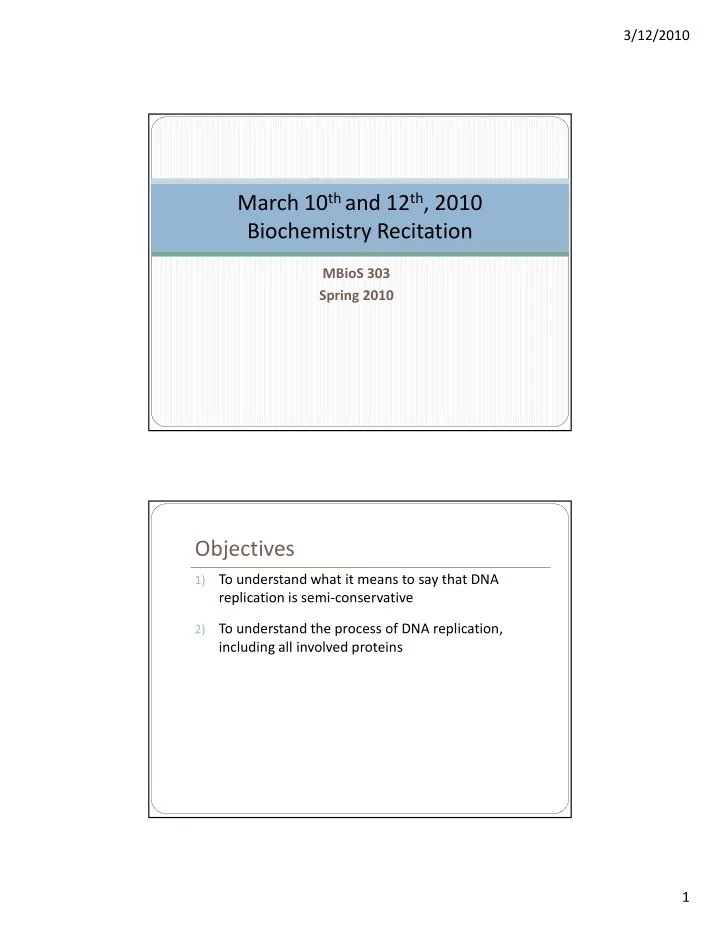

3/12/2010 March 10 th and 12 th , 2010 Biochemistry Recitation MBioS 303 Spring 2010 Objectives To understand what it means to say that DNA 1) replication is semi-conservative To understand the process of DNA replication, 2) including all involved proteins 1
3/12/2010 Objectives To understand what it means to say that DNA 1) replication is semi-conservative To understand the process of DNA replication, 2) including all involved proteins Replication Conservative or Semi-Conservative?? Genomes, 2 nd Ed. 2
3/12/2010 Objectives To understand what it means to say that DNA 1) replication is semi-conservative To understand the process of DNA replication, 2) including all involved proteins DNA Replication Bidirectionality Replication is bi-directional (proceeds in two 1) directions at once) 3
3/12/2010 DNA Replication General Principles Replication is bi-directional (proceeds in two 1) directions at once) New strands are always synthesized in the 5’ � 3’ 2) direction (meaning template strands are read in the 3’ � 5’ direction) DNA Replication Addition of dNTPs Molecular Biology of the Cell, 4 th Ed. 4
3/12/2010 DNA Replication Addition of dNTPs How does DNA Polymerase know what base to add next? DNA Replication Addition of dNTPs 5
3/12/2010 DNA Replication General Principles Replication is bi-directional (proceeds in two 1) directions at once) New strands are always synthesized in the 5’ � 3’ 2) direction (meaning template strands are read in the 3’ � 5’ direction) One strand is synthesized continuously , the other is 3) synthesized discontinuously DNA Replication Continuous vs. Discontinuous 6
3/12/2010 DNA Replication Required elements Template – why??? 1) Primer (short oligonucleotide that is complementary 2) and hydrogen bonded to template strand) with free 3’ OH group – why??? Lots of enzymes (over 20 in E. coli ) 3) DNA Replication A Closer Look � DNA Replication consists of three stages: Initiation 1. Elongation 2. Termination 3. 7
3/12/2010 DNA Replication Initiation Bacteria generally have only one circular � chromosome In E. coli , there is one origin of replication on this � chromosome Contains five binding sites for DnaA ATPase Containes three adjacent AT rich sequences (DUE) DNA Replication DnaA Genomes, 2 nd Ed. Binding of DnaA results in supercoiling � � Supercoiling compensated for by relaxation in DUE Results in single-stranded template � What binds the single-stranded template, and why? 8
3/12/2010 DNA Replication DnaC ATPase � � Loads DnaB DNA Replication DnaB � Helicase Moves along single-stranded template in 5’ � 3’ direction, creating � supercoiling in front (relieved by topoisomerase II, aka DNA gyrase) � One DnaB complex at each replication form � Linked directly or indirectly to all other proteins in replication fork 9
3/12/2010 DNA Replication Elongation Leading strand synthesis and lagging strand � synthesis differ � What’s the same between the two? DNA helicases unwind parent DNA 1. Topoisomerases relieve topological stress 2. Each separated strand stabilized by single-stranded DNA 3. binding proteins Chains elongated by DNA polymerase 4. DNA Replication DNA Polymerase 10
3/12/2010 DNA Replication Leading Strand Synthesis Short RNA primer 1. synthesized by primase DNA polymerase core 2. subunits (linked to DnaB) add dNTPs to growing strand in 5’ � 3’ direction Strand synthesis 3. Molecular Biology of the Cell proceeds continuously DNA Replication Lagging Strand Synthesis A single DNA polymerase complex is used at each 1. replication fork, complicating this process One of DNA core subunits used for continuous • leading strand synthesis Second core subunit cycles from one Okazaki • fragment to the next 11
3/12/2010 DNA Replication Lagging Strand Synthesis DNA Replication To see the movie that was here (along with a couple of other good videos) check out the ‘Useful Links’ tab on the webpage. 12
3/12/2010 DNA Replication Prokaryotes vs. Eukaryotes Prokaryotes: one origin of replication • Eukaryotes: multiple origins of replication (why?) • Eukaryotes have linear chromosomes, not circular. • What problem does this cause? Why? • How do the cells solve it? • Have a great spring break! 13
Recommend
More recommend